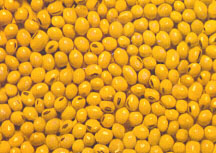
Prepared by
Katherine Cason, PhD, RD
Page 2 of 4
Soy contains several different
phytochemicals which have been associated with relief of symptoms
of menopause, decreasing bone resorptio, and decreasing risk
of developing certain types of cancers, kidney and cardiovascular
diseases.
|
|
Click here for the printable (Word) version of the lesson
Where
Can You Find Phytochemicals?
Fruits, vegetables, legumes and whole grains are full of phytochemicals.
In fact, orange juice has 59 known phytochemicals; broccoli has
at least 40, and the herb tarragon has 70. Some of the plant
foods you find these chemicals in are:
|
Foods |
Phytochemical |
May
Help Prevent |
|
Cruciferous vegetables:
broccoli, cauliflower, cabbage,dark leafy greens |
organosulfur
glucosinolates |
cancer |
|
Soy Foods |
isoflavones
saponins |
cancer, heart disease |
|
Tomatoes and watermelons |
lycopene |
prostate cancer, heart disease |
|
Onions, garlic, scallions, chives |
allium compounds |
cancer |
|
Grapes, strawberries, cranberries,
nuts, blackberries, raspberries |
ellagic acid |
cancer |
|
Citrus fruits |
monoterpenes |
cancer |
Soy
Foods
 One of the foods that contains
several types of phytochemicals is soybeans. Soy contains several
different phytochemicals which have been associated with relief
of symptoms of menopause, decreasing bone resorption and decreasing
risk of developing certain types of cancers, kidney and cardiovascular
diseases. In the United States, soy products have had a negative
connotation. Soy protein was considered poor man's steak,
a way to extend ground meat. Despite the negativity associated
with consuming soy products, recent research about the health
benefits of soy make it worthwhile to give it a second look. One of the foods that contains
several types of phytochemicals is soybeans. Soy contains several
different phytochemicals which have been associated with relief
of symptoms of menopause, decreasing bone resorption and decreasing
risk of developing certain types of cancers, kidney and cardiovascular
diseases. In the United States, soy products have had a negative
connotation. Soy protein was considered poor man's steak,
a way to extend ground meat. Despite the negativity associated
with consuming soy products, recent research about the health
benefits of soy make it worthwhile to give it a second look.
What are the Health Benefits of Soy?
Recent research suggests that soy protein and its phytochemical
compounds may aid in the prevention of some of the major chronic
diseases in the United States, including heart disease, cancer
and osteoporosis, as well as reduce the symptoms of menopause.
The exact component of soybeans responsible for the health-promoting
effect is still unknown and it is being researched. Researchers
speculate that the synergistic effect of the soluble fiber, phytoestrogens,
saponins, phytate and other components may be responsible for
the health benefits of soy foods.
   [ LESSONS || SITE
MAP || LOCAL AGENTS || RESOURCES || PEOPLE ]
[ LESSONS || SITE
MAP || LOCAL AGENTS || RESOURCES || PEOPLE ]
 Issued in furtherance of Cooperative Extension
work, Acts of Congress of May 8 and June 30, 1914, in cooperation
with the United States Department of Agriculture. The Louisiana
Cooperative Extension Service provides equal opportunities in
programs and employment. Information and Graphics on this site
are copyright protected by LSU Agricultural Center's Louisiana Cooperative Extension Services.
For more information
on the EFNEP program, contact EFNEPMail@agcenter.lsu.edu. Issued in furtherance of Cooperative Extension
work, Acts of Congress of May 8 and June 30, 1914, in cooperation
with the United States Department of Agriculture. The Louisiana
Cooperative Extension Service provides equal opportunities in
programs and employment. Information and Graphics on this site
are copyright protected by LSU Agricultural Center's Louisiana Cooperative Extension Services.
For more information
on the EFNEP program, contact EFNEPMail@agcenter.lsu.edu.
|